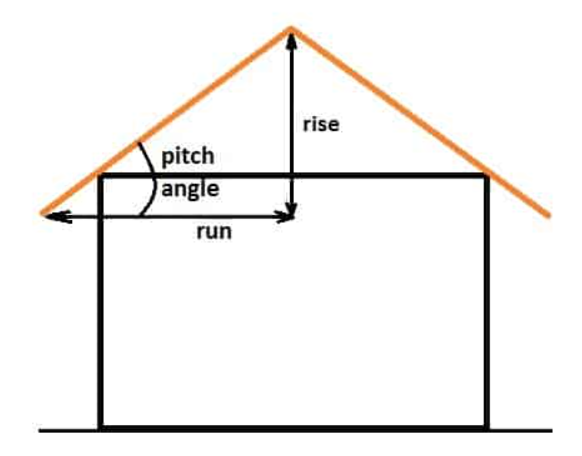 Home
Home
 Back
Back
A roof pitch calculator is a tool to determine the slope of a roof. It converts measurements into various formats such as degrees, radians, gradians, or as a ratio (x:12). By inputting the rise and run, users can quickly find the pitch, which is crucial for selecting appropriate roofing materials, ensuring compliance with building codes, and assessing roof walkability.

Step 1: Measure the rise and run of the roof.
Step 2: Enter the values in the calculator.
Step 3: The calculator will compute the rafter length, pitch percent, pitch angle, and pitch as x:12.
Formula for rafter length: $$\text{Rafter Length} = \sqrt{\text{Rise}^2 + \text{Run}^2}$$
Formula for pitch percent: $$\text{Pitch Percent} = \left(\frac{\text{Rise}}{\text{Run}}\right) \times 100$$
Formula for pitch angle: $$\text{Pitch Angle} = \arctan\left(\frac{\text{Rise}}{\text{Run}}\right)$$
Formula for pitch as x:12: $$\text{Pitch as x:12} = \left(\frac{\text{Rise}}{\text{Run}}\right) \times 12$$
You can calculate the pitch of a roof by measuring its vertical rise and horizontal run. Here's what you'll need:
Common roof pitch multipliers can be used to calculate the total roof area.
| Roof Pitch (in/12) | Multiplier |
|---|---|
| 0/12 | 1 |
| 1/12 | 1.0035 |
| 2/12 | 1.0138 |
| 3/12 | 1.0308 |
| 4/12 | 1.0541 |
| 5/12 | 1.0833 |
| 6/12 | 1.118 |
| 7/12 | 1.1577 |
| 8/12 | 1.2019 |
| 9/12 | 1.25 |
| 10/12 | 1.3017 |
| 11/12 | 1.3566 |
| 12/12 | 1.4142 |
| 13/12 | 1.4743 |
| 14/12 | 1.5366 |
| 15/12 | 1.6008 |
| 16/12 | 1.6667 |
| 17/12 | 1.7341 |
| 18/12 | 1.8028 |
| 19/12 | 1.8727 |
| 20/12 | 1.9437 |
| 21/12 | 2.0156 |
| 22/12 | 2.0883 |
| 23/12 | 2.1619 |
| 24/12 | 2.2361 |
| Type of Shingle | Advantages | Disadvantages |
|---|---|---|
| Asphalt Shingles |
|
|
| Wood Shingles |
|
|
| Metal Shingles |
|
|
| Clay or Concrete Tiles |
|
|
| Standard Roof Pitch | Degrees | Percentage |
|---|---|---|
| 0.25:12 | 1.193° | 2.08 % |
| 0.5:12 | 2.386° | 4.17 % |
| 1:12 | 4.76° | 8.33 % |
| 2:12 | 9.46° | 16.67 % |
| 3:12 | 14.04° | 25 % |
| 4:12 | 18.43° | 33.33 % |
| 5:12 | 22.62° | 41.67 % |
| 6:12 | 26.57° | 50 % |
| 7:12 | 30.26° | 58.33 % |
| 8:12 | 33.69° | 66.67 % |
| 9:12 | 36.87° | 75 % |
| 10:12 | 39.81° | 83.33 % |
| 11:12 | 42.51° | 91.67 % |
| 12:12 | 45° | 100 % |
| 13:12 | 47.29° | 108.33 % |
| 14:12 | 49.4° | 116.67 % |
| 15:12 | 51.34° | 125 % |
| 16:12 | 53.13° | 133.33 % |
| 17:12 | 54.78° | 141.67 % |
| 18:12 | 56.31° | 150 % |
| 19:12 | 57.72° | 158.33 % |
| 20:12 | 59.04° | 166.67 % |
| 21:12 | 60.26° | 175 % |
| 22:12 | 61.39° | 183.33 % |
| 23:12 | 62.45° | 191.67 % |
| 24:12 | 63.43° | 200 % |
| 25:12 | 64.36° | 208.33 % |
| 26:12 | 65.22° | 216.67 % |
| 27:12 | 66.04° | 225 % |
| 28:12 | 66.80° | 233.33 % |
| 29:12 | 67.52° | 241.67 % |
| 30:12 | 68.20° | 250 % |
The standard roof pitch is not fixed and is influenced by various factors. Specifically, climate, roofing material, and architectural style and aesthetics are key factors in determining roof pitch.
In areas with heavy snowfall, a steeper pitch helps snow slide off; whereas in windy regions, a shallower pitch may be more conducive to roof stability.
Additionally, different roofing materials have their own minimum pitch requirements for drainage and performance. For example, asphalt shingles typically require a minimum pitch of 4:12 or 6:12, while metal roofs can accommodate lower pitches. As for architectural styles, certain styles complement specific roof pitches, such as the low-pitch roofs of ranch houses and the high-pitch roofs of Victorian houses.
Therefore, when planning roof pitch, it is advisable to consult a professional architect or contractor to obtain advice that best suits your needs and geographical location.
The minimum roof pitch also depends on the type of roofing material used.
Asphalt shingles generally require a pitch of at least 2:12 or 4:12 (depending on the manufacturer's recommendations) to ensure proper drainage and prevent leakage. In contrast, metal roofs can handle lower pitches, with some metal roofing panels suitable for pitches as low as 1:12, while other panels may require a minimum pitch of 3:12, depending on seam types and the use of lap sealants.
Membrane roofs are designed specifically for low-pitch applications, with a standard minimum pitch of approximately 1/4:12, but some insurance companies may require a steeper pitch (such as 1/2:12) for optimal performance. However, these are only general guidelines.
It is important to refer to the recommendations of specific roofing material manufacturers to understand the minimum safe pitch of their products. Additionally, be aware that local building codes may have specific requirements for roof pitch.
Therefore, when deciding on roof pitch, please consult a professional roofer or architect to ensure your roof meets all safety and performance standards.